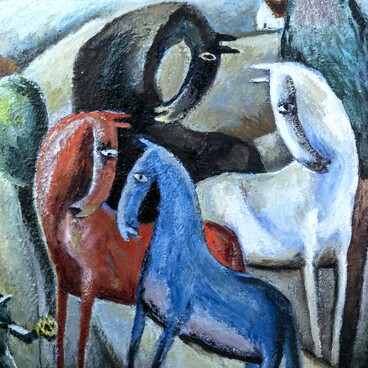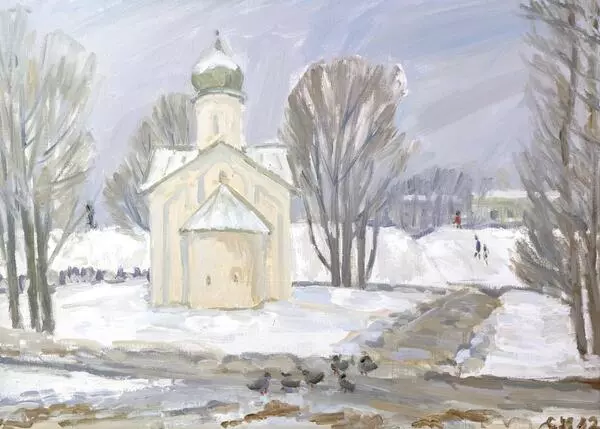The complex of buildings of the Antoniev Monastery (St. Anthony’s Monastery) is located outside of Old Novgorod — on the right bank of the Volkhov River, to the north of the fortifications around the Novgorod Kremlin.
This monastery is one of the oldest in the Novgorod Land. The hagiography of its founder and first hegumen, Saint Anthony the Roman, mentions the exact date of the construction — 1106.
A monk from the Kyiv-Pechersk Lavra, Bishop Nikita, who was an authoritative figure in Novgorod, supported Anthony and his monastery.
A detailed account of the miraculous appearance of Anthony on the shores of the Volkhov River is given in his hagiography. According to it, the saint sailed to the village of Volkhov near Novgorod on a piece of rock, on which he had previously prayed in solitude in his native Italy. The stone with the imprint of Anthony’s foot is kept among the relics of the monastery.
Historians suggest that Anthony the Roman was a monk of Greek origin, who practiced asceticism in one of the Greek monasteries on the Italian Peninsula. This is confirmed by the mention in Anthony’s hagiography of a certain Gotfin, a translator from Greek, who was with Anthony to help him communicate with the Novgorodians.
Researchers believe that the time of the saint’s arrival in Rus was connected with the religious and political conflict in Southern Italy in the late 11th century. The expansion of Byzantine Norman mercenaries and their war primarily with the Emirate of Sicily led to clashes with Byzantium. Political disagreements caused the confrontation between the Western and Eastern churches. The persecution of Orthodox Christians began. St. Anthony’s commitment to the Orthodox faith and his condemnation of the “Latins” are highlighted in his hagiography.
According to another version, Anthony came to Novgorod as a missionary. There are other sources that prove St. Anthony’s connection with Byzantium. There was a hospital and an almshouse at the monastery, as evidenced by the images of healers on the frescoes of 1125. The establishment of such hospitals, almshouses and hospices was directly prescribed in the Studite typikon, written by a monk Theodore the Studite and revised in the 11th century by Alexius Studites, an ecumenical patriarch of Constantinople.
In the foreign land, Anthony the Roman faced many challenges, which did not prevent him, however, from founding one of the most famous Novgorod monasteries with a majestic cathedral and paintings in the Greek style.
In the painting by Svetlana Evgenievna Ivanova, the monastery is organically inscribed in the evening landscape. The artist won a gold medal at the Viktor Popkov competition. She actively takes part in Russian and international plein air sessions, contests and exhibitions, including the “Pastel Colors of Russia”, “Art Moment”, and “Slavic Brotherhood”.
This monastery is one of the oldest in the Novgorod Land. The hagiography of its founder and first hegumen, Saint Anthony the Roman, mentions the exact date of the construction — 1106.
A monk from the Kyiv-Pechersk Lavra, Bishop Nikita, who was an authoritative figure in Novgorod, supported Anthony and his monastery.
A detailed account of the miraculous appearance of Anthony on the shores of the Volkhov River is given in his hagiography. According to it, the saint sailed to the village of Volkhov near Novgorod on a piece of rock, on which he had previously prayed in solitude in his native Italy. The stone with the imprint of Anthony’s foot is kept among the relics of the monastery.
Historians suggest that Anthony the Roman was a monk of Greek origin, who practiced asceticism in one of the Greek monasteries on the Italian Peninsula. This is confirmed by the mention in Anthony’s hagiography of a certain Gotfin, a translator from Greek, who was with Anthony to help him communicate with the Novgorodians.
Researchers believe that the time of the saint’s arrival in Rus was connected with the religious and political conflict in Southern Italy in the late 11th century. The expansion of Byzantine Norman mercenaries and their war primarily with the Emirate of Sicily led to clashes with Byzantium. Political disagreements caused the confrontation between the Western and Eastern churches. The persecution of Orthodox Christians began. St. Anthony’s commitment to the Orthodox faith and his condemnation of the “Latins” are highlighted in his hagiography.
According to another version, Anthony came to Novgorod as a missionary. There are other sources that prove St. Anthony’s connection with Byzantium. There was a hospital and an almshouse at the monastery, as evidenced by the images of healers on the frescoes of 1125. The establishment of such hospitals, almshouses and hospices was directly prescribed in the Studite typikon, written by a monk Theodore the Studite and revised in the 11th century by Alexius Studites, an ecumenical patriarch of Constantinople.
In the foreign land, Anthony the Roman faced many challenges, which did not prevent him, however, from founding one of the most famous Novgorod monasteries with a majestic cathedral and paintings in the Greek style.
In the painting by Svetlana Evgenievna Ivanova, the monastery is organically inscribed in the evening landscape. The artist won a gold medal at the Viktor Popkov competition. She actively takes part in Russian and international plein air sessions, contests and exhibitions, including the “Pastel Colors of Russia”, “Art Moment”, and “Slavic Brotherhood”.



